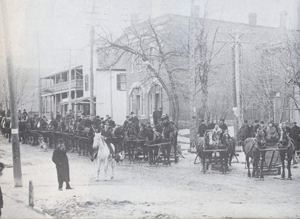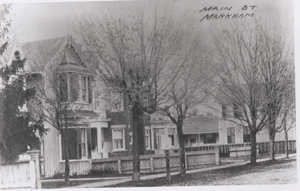


By 1857, Markham Village was a mix of factories, shops, and dwellings with Main Street as its core.
More than 1,000 people lived and worked there. New construction was made easier thanks to the many carpenters, joiners, builders, masons, tinsmiths, coopers, pump makers, blacksmiths, cabinet makers and machinists in the village. An ironmonger and a window and sash factory were also near at hand. Transportation was taken care of by wagon and carriage makers, harness makers, and saddlers. Everyday needs were met by a boot and shoe maker, tailors, jewellery and watchmakers, a butcher, a baker, and general and dry goods merchants. Other needs were attended to by physicians, insurance salesmen, a dentist, postmaster, tax collector, and barrister. There were inns, a school, churches for every denomination and the local news was reported by David Reesor in his weekly newspaper, The Economist.
In 1871, the Toronto & Nipissing Rail Road arrived and a station was built to the north of the village. The railway gave villagers access to new markets and items not previously available without considerable effort and expense. Some shops and industries competed successfully; others did not. More elegant hotels and dining facilities were built catering to the travelling public.
The general prosperity of the village resulted in the space between the commercial district and the railway station being developed and the village was officially incorporated on January 1, 1873. An impressive Town Hall was constructed at 96 Main Street in 1881 – a symbol of the village’s continuing success. Markham Village grew again when Mount Joy Village to the north was taken over on January 27, 1915.


